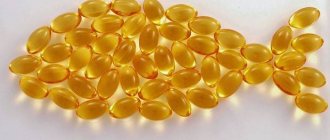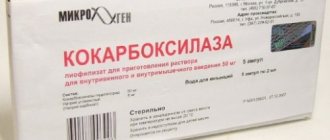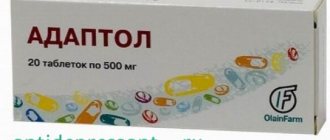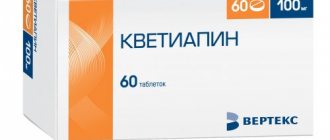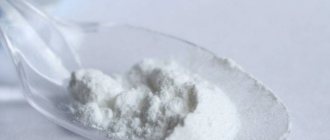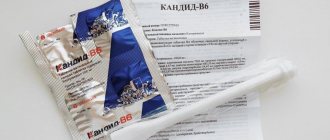Release form and composition
The dosage form of Valvir is film-coated tablets: color - almost white or white, biconvex, oval, on one side marked “VC2” (500 mg) or “VC3” (1000 mg) (500 mg each - 10 pcs. in blisters, 1 blister in a cardboard pack; 14 pcs in blisters, 3 blisters in a cardboard pack; 1000 mg - 7 pcs in blisters, 1 or 4 blisters in a cardboard pack).
Composition of 1 tablet:
- active substance: valacyclovir - 500 or 1000 mg (valaciclovir hydrochloride hydrate - 611.7 or 1223.4 mg);
- additional components: povidone K30 – 24.5/49 mg, microcrystalline cellulose – 59.6/119.2 mg, magnesium stearate – 4.2/8.4 mg;
- film coating: Opadry white Y-5-7068 (hypromellose 3cP – 7.35/14.7 mg, hyprolose – 6.3/12.6 mg, titanium dioxide – 4.2/8.4 mg, macrogol/PEG 400 – 2.1/4.2 mg, hypromellose 50cP – 1.05/2.1 mg) – 21/42 mg.
Peculiarities
The drug "Valvir" contains the main component valacyclovir, which has the ability to quickly transform into acyclovir and L-valine. The medication has an anti-inflammatory effect and acts in the fight against herpes simplex viruses, herpes zoster, human herpes virus type six and cytomegalovirus. Valvira contains sodium hydrochloride and auxiliary components such as magnesium stearate, povidone, microgol, hyprolysis, hypromellose and microcrystalline cellulose.
After oral administration, valacyclovir is rapidly absorbed from the gastrointestinal tract and is completely converted to acyclovir and L-valine. These components of the drug disperse through the liver, kidney and lung tissues, penetrate into the secretions secreted in the female vagina, and inside the watery blisters of herpes. "Valvir" is produced in the form of white tablets, which are placed in a blister plate and cardboard packaging.
Indications for use
- infections of the skin and mucous membranes caused by the herpes simplex virus, including newly diagnosed and recurrent genital herpes (therapy and prevention of relapses);
- herpes zoster (therapy);
- genital herpes (reduced infection of a healthy partner if Valvir is taken as suppressive therapy in combination with safe sex);
- labial herpes (therapy);
- cytomegalovirus infection (CMV) developing during organ transplantation (prevention to reduce the severity of acute graft rejection in patients with kidney transplants, the likelihood of developing opportunistic infections and other viral infections caused by Varicella zoster and Herpes simplex viruses) in children over 12 years of age and adults.
Causes of herpes
A viral disease is characterized by the appearance of small bubbles, grouped together and localized in different parts of the body. The most common type of disease is the labial one, in which a rash appears on the lips, membranes of the nasal cavity and mouth. Herpes is believed to be a sign of a weakened immune system.
Infection with the herpes virus occurs through contact with areas of skin on which there is a rash. Genital herpes is often asymptomatic and manifests itself not in the carrier, but in the infected partner. The main reason for the development of this pathology is the frequent change of sexual partners and lack of personal hygiene.
Chickenpox and herpes zoster are consequences of infection with herpes type 3. In addition to rashes, the disease causes increased body temperature, severe itching, and fever. For such disorders, many doctors recommend taking the systemic antiviral drug Valvir.
The fifth type of herpes is the causative agent of cytomegalovirus, which occurs predominantly in the male half of the population. The disease is especially dangerous for pregnant women.
Contraindications
Absolute:
- kidney and bone marrow transplantation;
- HIV infection in clinically expressed forms with a CD4+ lymphocyte count of less than 100/μl;
- age up to 12 years (with CMV therapy), up to 18 years (prescribed for other indications);
- individual intolerance to the components of the drug, as well as acyclovir.
Relative (prescribing Valvir requires caution in the presence of the following diseases/conditions):
- renal failure;
- HIV infection in clinically expressed forms;
- combined use with nephrotoxic drugs;
- pregnancy and lactation (use of Valvir is possible only after assessing the ratio of expected benefits to possible risks).
General recommendations
Treatment methods for herpes infection depend on the type of illness and the age of the patient. Therapy is always aimed at suppressing the replication of the virus, because it is impossible to completely remove it from the body. Systemic medications are indicated for use in cases of serious pathology, when there is a huge risk of rash damage to the mucous membranes and internal organs. Topical medications will also be beneficial. They are used for infection with herpes types 1 and 2, which manifests itself as a rash on the lips and face.
It is advisable to take antiherpetic tablets for chickenpox in adults. This category of patients suffers from the disease much more severely than children, and without the use of such medications it can be extremely difficult to achieve an improvement in their condition. Doctors recommend starting to take Valvir and other similar medications at the first symptoms of chickenpox.
In parallel with treatment with antiviral drugs, doctors often recommend taking antihistamines to relieve discomfort in the form of itching and burning of the skin. Ointment and cream with antiherpetic components will ensure rapid healing of wounds. However, for the treatment of children they are used only in extreme cases and only after consultation with a pediatrician.
Treatment with antiherpetic drugs is carried out with extreme caution in pregnant women and children. The need to use systemic medications can only be determined by a doctor after an examination.
Directions for use and dosage
Valvir is taken orally.
Recommended dosage regimen:
- herpes zoster (treatment): 3 times a day, 1000 mg for a course of 7 days;
- herpes simplex (treatment): 2 times a day, 500 mg for a course of 3 or 5 days (for relapses) or up to 10 days (for the first severe episode); for relapses, Valvir is recommended to be prescribed in the prodromal period or when the first symptoms of the disease occur in the form of tingling, itching, burning;
- herpes labialis (treatment): 2 times 2000 mg for one day (the second dose should be taken after about 12 hours, but not earlier than 6 hours after the first dose; longer treatment is ineffective);
- herpes simplex (prevention): with preserved immunity - 500 mg once a day; with very frequent relapses (from 10 times a year) - 2 times a day, 250 mg; adult patients with immunodeficiency - 2 times a day, 500 mg. Course duration – from 4 to 12 months;
- genital herpes (prevention of infection of a healthy partner): infected heterosexual adults with preserved immunity with relapses up to 9 times a year - 1 time per day, 500 mg for a course of 1 year or more; for regular sexual activity, Valvir is taken daily; for irregular sexual intercourse, therapy begins 3 days before the expected sexual intercourse;
- CMV (prevention): adults and adolescents from 12 years of age - 4 times a day, 2000 mg (as soon as possible after transplantation) for a course of 90 days; patients at high risk may be prescribed longer treatment.
With a significant decrease in renal function, lower doses are indicated (depending on creatinine clearance).
Shingles:
- 15–30 ml/min – 2 times a day, 1000 mg;
- < 15 ml/min – 1000 mg once a day.
Herpes simplex: < 15 ml/min – 500 mg once a day.
Labial herpes:
- 31–49 ml/min – 2 times within 1 day, 1000 mg;
- 15–30 ml/min – 2 times during 1 day, 500 mg each;
- < 15 ml/min – 500 mg once a day.
Herpes simplex (patients with preserved/reduced immunity): < 15 ml/min – 250/500 mg once a day.
Genital herpes (to reduce infection): < 15 ml/min – 250 mg once a day.
CMV:
- ≥ 75 ml/min – 4 times a day, 2000 mg;
- 50–74 ml/min – 4 times a day, 1500 mg;
- 25–49 ml/min – 3 times a day, 1500 mg;
- 10–24 ml/min – 2 times a day, 1500 mg;
- < 10 ml/min or hemodialysis – 1500 mg once a day.
For patients on hemodialysis, Valvir is recommended to be used immediately after the end of the session in the same dose as for patients with creatinine clearance <15 ml/min.
For patients on dialysis, the drug should be taken after the end of the hemodialysis session.
Creatinine clearance should be determined frequently, particularly during periods when renal function changes rapidly, such as immediately after engraftment or transplantation. The dose of Valvir should be adjusted according to creatinine clearance.
Can I take Valvir?
Valvir is prescribed during pregnancy only when the expected effect of treatment for the expectant mother significantly exceeds the risk to the fetus. It should be borne in mind that no drug can completely get rid of the herpes virus. In this case, therapy will be aimed at suppressing the development of the pathogen and preventing transmission of the infection to the baby.
If a herpetic rash appears on the lips during pregnancy, it will be sufficient to use local remedies in the form of gels and ointments with acyclovir and penciclovir for treatment. "Valvir" and other similar systemic medications are needed only in case of primary infection. Only the attending physician can prescribe them. It is permissible to use the medication during lactation.
Side effects
Adverse reactions observed most often while taking Valvir: nausea, headache. More serious disorders include hemolytic-uremic syndrome/thrombotic thrombocytopenic purpura, neurological disorders, and acute renal failure.
Possible violations (> 10% - very often; > 1% and < 10% - often; > 0.1% and < 1% - infrequently; > 0.01% and < 0.1% - rarely; < 0.01 % – very rarely; with unknown frequency – if it is impossible to estimate the frequency of development of disorders):
- immune system: very rarely - anaphylaxis;
- digestive system: often – nausea; rarely - abdominal discomfort, including abdominal pain, vomiting, diarrhea; very rarely - reversible disorders of functional liver tests (in some cases regarded as manifestations of hepatitis);
- lymphatic system and blood: very rarely - leukopenia (in most cases in patients with reduced immunity), thrombocytopenia;
- respiratory system: infrequently – dyspnea;
- nervous system and psyche: often – headache; infrequently – agitation, including aggressive behavior; rarely - decreased mental capacity, dizziness, hallucinations, confusion; very rarely - ataxia, agitation, dysarthria, tremor, psychotic symptoms, including mania, encephalopathy, depression, convulsions, coma (disorders are reversible, usually observed in patients with impaired renal function or against the background of other diseases);
- skin and subcutaneous tissue: uncommon – rashes, including manifestations of photosensitivity; rarely – itching;
- urinary system: uncommon – hematuria (often associated with other renal disorders); rarely - functional kidney disorders; very rarely - acute renal failure, renal colic (may be associated with functional disorders of the kidneys); due to the likelihood of sedimentation of crystals of the active substance in the lumen of the renal tubules during therapy, it is recommended to maintain an adequate drinking regime;
- hematopoietic organs: with unknown frequency - aplastic anemia, neutropenia, thrombotic thrombocytopenic purpura, leukoclastic vasculitis;
- organs of vision: with unknown frequency - visual impairment;
- skin: with unknown frequency - erythema multiforme;
- allergic reactions: very rarely - angioedema, urticaria;
- laboratory parameters: with unknown frequency - hypercreatininemia, decreased hemoglobin;
- others: in severe immune disorders, especially in patients with acquired immune deficiency in an advanced stage and long-term receiving high doses of valacyclovir (8000 mg per day), cases of microangiopathic hemolytic anemia, renal failure, thrombocytopenia, in some cases in combination (such complications were observed in patients with the same diseases, but not receiving valacyclovir); with unknown frequency - fatigue, nasopharyngitis, dysmenorrhea, tachycardia, arthralgia, facial edema, respiratory tract infections, increased blood pressure; additionally in children – dehydration, fever, rhinorrhea.
"Acyclovir" or "Valvir"?
The medicine "Valvir" is considered one of the most effective remedies for herpes infection. The active substance of the drug is converted into another component when exposed to liver enzymes. Thanks to this, it is possible to achieve a longer therapeutic effect than when taking regular acyclovir.
When treated with Acyclovir tablets, you need to take 4-6 of them per day, which causes some inconvenience. This can be avoided thanks to the drug "Valvir". In most cases, you only need to take 2 tablets of the drug per day. At the same time, Acyclovir is sometimes used in pediatric practice, for example, for severe chickenpox in children.
Among doctors and patients, Valvir is still the most popular. According to most reviews, the medication is well tolerated and rarely causes side effects. Quite often prescribed for the treatment of chickenpox in adults.
special instructions
Long-term use of high doses of Valvir in conditions that are accompanied by severe immunodeficiency (bone marrow/kidney transplantation, clinically pronounced forms of HIV infection) can lead to hemolytic-uremic syndrome and the occurrence of thrombocytopenic purpura, even death. Therapy is discontinued in cases of adverse reactions from the central nervous system, including agitation, hallucinations, confusion, delirium, convulsions and encephalopathy.
If there is a possibility of dehydration, especially in elderly patients, it is necessary to ensure adequate hydration of the body. An increased risk of developing neurological complications is observed in patients with renal failure.
In case of impaired liver function in patients with mild/moderate liver cirrhosis (while maintaining the synthetic function of the liver), no dose adjustment of Valvir is required. The condition of patients with severe liver cirrhosis (with impaired synthetic function of the liver and the presence of shunts between the common vascular bed and the portal system) requires observation due to the lack of sufficient data.
In cases of side effects that affect the speed of psychomotor reactions, caution must be exercised when driving.
Pharmacokinetics
After taking the drug, valacyclovir is absorbed quite quickly from the gastrointestinal tract. A single dose of tablets (0.25-2 g) reaches maximum concentration in the blood after 1-2 hours. At the same time, the bioavailability of the drug is 54%, regardless of food intake.
The association of acyclovir with plasma is low and is approximately 15%. This substance is very quickly distributed throughout all tissues. It can be found in the liver, kidneys, muscles and lungs. Acyclovir also penetrates into the cerebrospinal fluid, vaginal secretions and herpetic vesicles.
In people with normal kidney function, the half-life of this drug is 3 hours. Valaciclovir is excreted in the urine.
Drug interactions
When Valvir is used in combination with certain drugs/substances, the following effects may develop:
- nephrotoxic drugs, including aminoglycosides, organic platinum compounds, iodinated contrast agents, methotrexate, pentamidine, foscarnet, cyclosporine and tacrolimus: the combination requires caution, especially in cases of renal impairment, and regular monitoring of renal function is also necessary;
- drugs that compete with acyclovir for the elimination pathway (at high doses of valacyclovir - 4000 mg per day): there is a possibility of an increase in the plasma concentration of drugs (one or both) or their metabolites;
- mycophenolate mofetil: the AUC (area under the concentration-time curve) of acyclovir and the inactive metabolite mycophenolate mofetil increases.
"Valvir": analogues
Systemic treatment of herpes infection brings rapid relief and significantly speeds up the recovery process. Narrowly targeted drugs can suppress the development of the herpes simplex virus. Medicines based on valacyclovir are considered effective and safe: Vairova, Valtrex, Virdel, Valvir. Reviews from patients confirm the powerful therapeutic properties of the drugs. It is extremely dangerous to take them without a specialist’s prescription!
Medicines containing acyclovir can also prevent the spread of infection. Most drugs containing this substance are available in the form of an ointment for topical use. In tablets, the concentration of the active substance is low, which requires an increase in the frequency of taking medications up to 4-5 times a day.
Effective analogues of "Valvir":
- "Zovirax".
- "Vivorax".
- "Geviran."
- "Herperax".
- "Valacyclovir."
- "Valtsikon".
- "Acyclostad".
- "Famvir."
Cases of pill overdose
What symptoms occur when taking the medicine “Valvir” incorrectly? Reviews from doctors indicate the following signs of overdose: nausea, confusion, vomiting, development of renal failure, headache, increased serum creatinine concentration, hallucinations, convulsions, agitation, coma.
Victims should be under constant medical supervision to identify symptoms of toxic exposure.
Hemodialysis allows you to completely remove acyclovir from the blood.
Pharmacological effect
The active component of the drug is quite quickly converted into L-valine and acyclovir under the specific action of valacyclovir hydrolase. Due to this, inhibitory activity is observed against a number of viruses: herpevirus (type 1, 2, 6), cytomegalovirus, Varicella zoster. It is worth considering that Valvir is not an antibiotic; it has no antimicrobial properties.
The mechanism of action is characterized by disruption of the DNA synthesis process of pathogenic microorganisms. As a result of phosphorylation under the influence of various enzymes, acyclovir is converted into acyclovir triphosphate. The short-term process of transformation of a substance such as acyclovir is completed by cellular kinases. Triphosphate compounds of acyclovir contribute to the destruction of DNA polymerase of viral cells, and the process of spreading the herpevirus is gradually blocked.
In some cases, low sensitivity of various herpeviruses to this drug is observed. This is due to a deficiency of thymidine kinase, which contributes to the active spread of certain strains of viruses.


